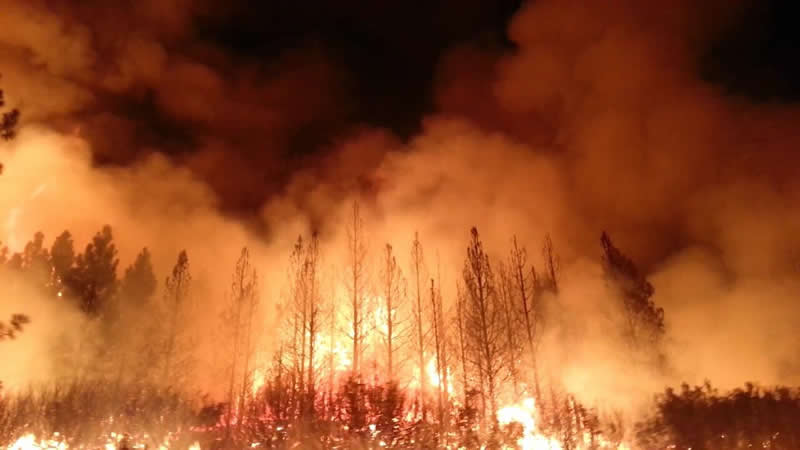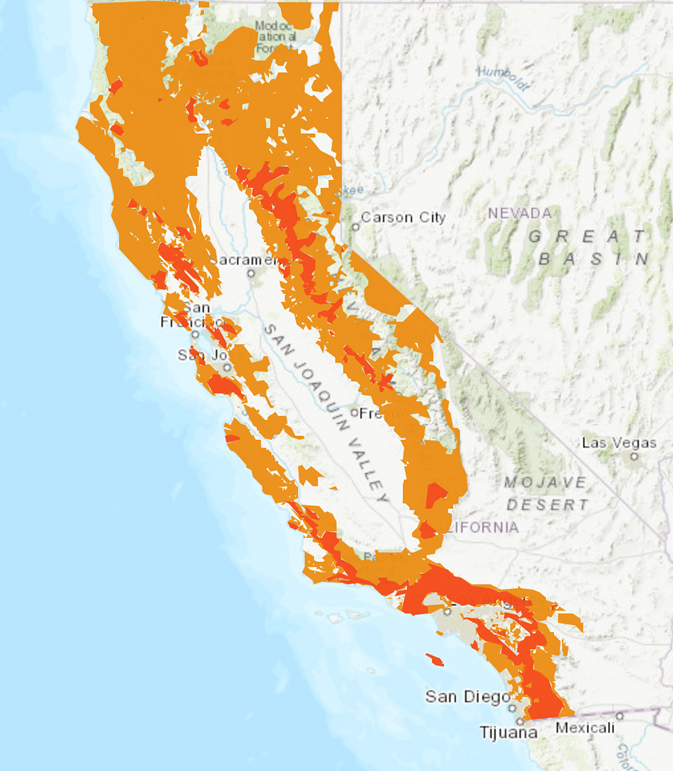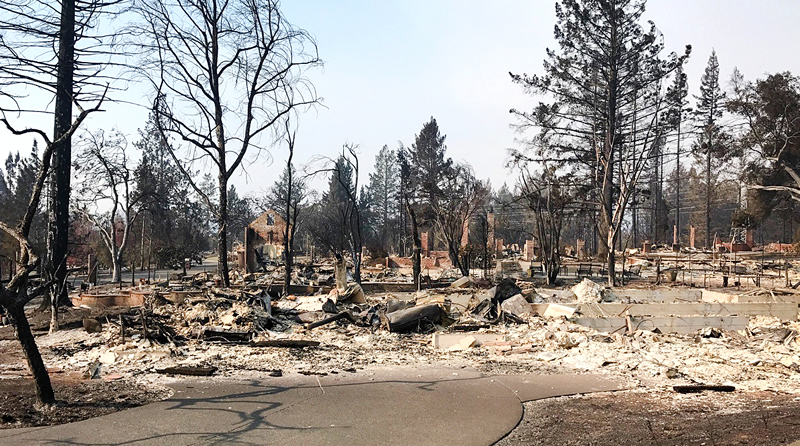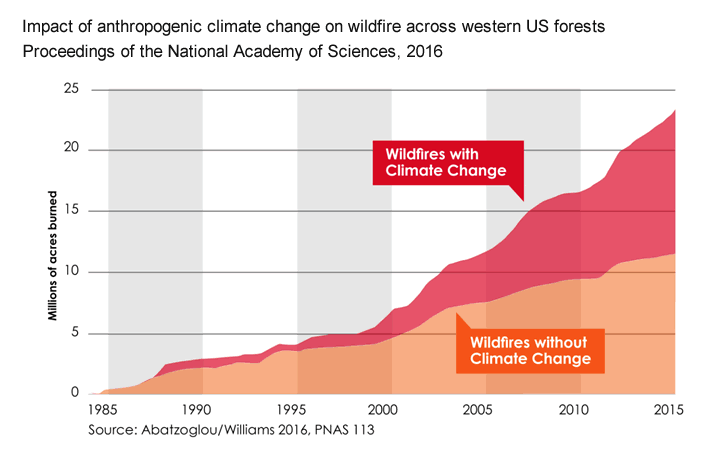California’s three largest utilities, San Diego Gas & Electric (SDG&E), Southern California Edison (SCE) and Pacific Gas and Electric Company (PG&E)PG&E – are planning to cut electric power to prevent wildfires this summer. It’s virtually unprecedented for a utility to voluntarily shut off power to large areas, but it appears that the inability of California utilities to cope with increasingly frequent climate-related disasters is prompting this radical new policy. PG&E has imposed power cuts for safety reasons in the past, but this year, five million people – or ten times more PG&E customers – could be affected, according to the Wall Street Journal.

Under the direction of the California Public Utilities Commission (CPUC), the utilities have launched a new campaign to inform the public about the shutoffs. A new website at www.PrepareForPowerDown.com declares, “In order to keep communities safe, your local energy company may need to turn off power during extreme weather or wildfire conditions. This is called a Public Safety Power Shutoff.”
“While Public Safety Power Shutoffs are more likely to occur in high fire-risk areas,” a joint press release from all three utilities says, “Californians could be impacted by emergency events and need to be prepared with a plan and an emergency kit.” The CPUC has published maps showing vulnerable areas where dense forests, severe winds and high-powered transmission lines could create extreme fire danger.

Power shutoffs can be triggered by a variety of conditions, including high winds, dry vegetation and low humidity. PG&E says that customers in fire-prone high-wind areas could be without electricity for up to five days, depending on weather conditions.
The utilities plan to notify their customers about the power outages via text message, email, phone calls and social media. People are being urged to develop emergency plans for their families that include backup charging for electronic devices, ways to manually open electric garage doors, and perhaps most importantly – plans for people who depend on electrically powered medical equipment in order to survive. PG&E currently has about 180,000 customers enrolled in a special program for people who need extra energy due to a medical condition.
According to the PG&E official who oversees the shutoffs, it’s likely that power outages will occur “multiple times” during this fire season. The Wall Street Journal reported that “This plan amounts to an admission by PG&E that it can’t always fulfill its basic job of delivering electricity both safely and reliably. Years of drought and a drying climate have turned the state’s northern forests into a tinderbox, and the utility has failed to make needed investments to make its grid sturdier.”
PG&E Used Power Cuts in 2018 to Minimize Wildfire Risks
While the new policy affects all of California’s major investor-owned utilities, PG&E, which provides electricity to one in 20 Americans and serves over 16 million people, has the biggest footprint. PG&E equipment, including downed power lines and exploding transformers, along with untrimmed vegetation, has been implicated in numerous wildfires. The company responded last year by using preventive power shut-offs during periods of high wind.
In October of 2018, PG&E cut the power to several small towns in the Napa Valley wine country. In Calistoga, CA, 60,000 people were affected, and some were without power for as long as three days. In Napa, Lake, and Sonoma Counties, residents suddenly found themselves without electricity as wind speeds reached 70 mph in the surrounding foothills. Community-wide power outages disable dozens of services we take for granted such as traffic lights, gas stations, well pumps and refrigeration units that keep food fresh in supermarkets. Emergency workers went from house to house in Calistoga checking on elderly residents and people who depend on electronically-powered medical equipment. Meanwhile wine country tourist businesses took a big hit and complained that there was no compensation from PG&E for their losses. Overall, the power cuts were unpopular and ratepayers complained that the utility was shifting its responsibilities on to the public.

The 2018 power cuts were actually a response to the catastrophic fire season of 2017, when over 200 small fires broke out in Northern California wine country during “red flag” high wind conditions; nearly two dozen of those small fires blew up into major wildfires. At the time, PG&E reported red flag conditions in 44 out of the 49 counties in its service area. The 2017 fires in Northern California killed 44 people and caused $14.5 billion in damages.
Last year, wildfires surpassed 2017 records for deadliness and destruction. The devastating Camp Fire killed 85 people in November, and an additional 8,526 fires raged across the state, burning 1.9 million acres and setting a new record for the most acreage burned in a single fire season. Insured losses of the 2018 fires are estimated at $12 billion.
Wildfires and Utility Power Cuts: Financial Impact
The consequences of wildfires have already been financially devastating to PG&E, which declared bankruptcy in early 2019, citing potential liabilities of $30 billion from two seasons of Northern California fires and ensuing law suits. PG&E also faces a $2 billion payout in fines and compensation for the victims and families of a 2010 San Bruno gas explosion that killed eight people and destroyed dozens of homes. That incident was unrelated to wildfires but it also involved aging and poorly maintained infrastructure.
Last month, as part of a new, court-ordered wildfire prevention plan, a judge barred PG&E from paying out dividends to its shareholders, and said he would supervise the company’s plan to remove the vegetation that was interfering with power lines, calling the company’s maintenance efforts to date “dismal.”
According to California Governor Gavin Newsom, wildfire costs are also threatening the financial health of the other two major investor-owned utilities in California, so he created a “Strike Force” to address the destabilizing effects of catastrophic wildfires on utility finances. The Strike Force report, “Wildfires and Climate Change: California’s Energy Future,” says a healthy state economy requires the financial survival of the state’s utilities. However, it also says that the increased risk and costs of climate change must be shared equally by all stakeholders, and cannot simply be passed from the utilities to their customers.
How should utilities prepare for climate risk and who should pay for it?
California is battling the consequences of a known five-year drought, but temperatures continue to rise and forest areas continue to dry out. The fire season is growing longer every year and now extends throughout the entire year in some parts of the state. More than half of PG&E’s territory is now considered to be in areas of extreme or high fire risk, and thus a candidate for the new policy on power cuts.

Meanwhile, the company says it could take over five years to conduct inspections and implement infrastructure improvements that would reduce fire danger, including trimming trees that are likely to fall on power lines, and making the high-voltage transmission system more fire resistant. For PG&E, these improvements entail work stretching across daunting distances, 5,500 miles of transmission and 25,000 miles of distribution line through high fire-threat areas. At the very least this means intermittent “prevention” outages will become common over the next five years while the utility catches up on delayed maintenance. But given the changing conditions of California’s forests, which are clearly drying out, can vegetation growth even be continuously and safely maintained over such areas?
Unfortunately, the same could be said of the entire Western United States, where climate scientists have long predicted increasing drought conditions. In recent years, rising temperatures and dryness have increased the amount of acreage burned annually across Oregon, Washington, Idaho, Montana, Wyoming, Colorado, Utah, Arizona and New Mexico. To make matters even riskier, many of these states are undergoing a surge in population growth. That in turn is causing rapid development of heavily forested wildland-urban environments and exposing even more people to increased fire danger.
Is utility reorganization a solution?
In the face of PG&E bankruptcy and the increased risk of catastrophic fires, elected officials, judges and citizen groups have proposed multiple strategies to protect the safety of California ratepayers. Aside from the “Power Down” strategy, there have been calls to reorganize PG&E, in hopes that a different corporate structure would make the company a better manager of climate risk. Reorganization plans include breaking PG&E into regional service territories, creating multiple municipal utilities that could be owned by local governments, splitting PG&E’s generation and transmission assets, or even creating a new company entirely. The City of San Francisco is seriously considering buying PG&E’s local grid and creating a municipal utility. While the solutions may vary, it’s clear that many Californians want a safer and more reliable utility that can focus on local needs, and respond more appropriately to fire threats. Is PG&E simply negligent or facing insurmountable challenges?
Microgrid investments could provide increased resilience for fire-threatened communities
It’s ironic that California – as the world’s fifth largest economy, larger than the UK – is now resorting to measures that we, at HOMER Energy, often see taken in developing countries. In many parts of the world, when the electricity load is too great, or when there are problems on the grid, electricity is simply cut off. These can be random outages, or they can be planned to make the most efficient use of whatever power is available. For decades now, developing countries have been building small, isolated grids – microgrids or minigrids as they are called in some countries – to provide community power that is more reliable than what large utilities can provide.

In a similar fashion, microgrids can help California communities withstand the uncertainty of sudden utility power cuts, and partially dampen the economic impacts. The most cost-effective solution in the short-term is to design microgrids that can maintain critical loads. These are systems that can meet the requirements of emergency service command centers, police and fire stations, schools, hospitals and other critical facilities. Communities can decide whether to include strategically located gas stations and supermarkets – or whatever they choose. In the case of a small community, a microgrid that integrates residential power systems might be able to provide power to everyone if the main power grid goes down.
In fact, the resilience of at least one California microgrid was clearly demonstrated during the 2017 fires in Northern California. In this case, the Stone Edge microgrid continued to function for 10 days while fires burned around it. Not only that, even after the farm was evacuated and surrounded by power outages, the microgrid continued to operate irrigation pumps and other key services as it was monitored and managed remotely via cell phone. The open source Stone Edge microgrid has a combination of solar PV, multiple types of batteries, fuel cells, a natural gas generator and a variety of inverters.
How would microgrids work to maintain power in California communities when utilities trigger a “powerdown” event?
It’s important to remember that, for multiple reasons, typical grid-tied solar systems will not function when the grid goes down unless they have special switchgear and inverters that allow them to function in microgrid mode, cutting themselves off from the grid. This is to prevent power from flowing into the grid while utility workers are working on it – a potentially fatal problem. That is why all grid-tied renewable energy systems are required to have emergency shut-off switches that prevent them from exchanging power with the grid – in either direction – when the grid goes down. But, in the case where a smaller distribution grid can “island” or detach itself from the main grid, renewable energy resources, batteries and possibly generators, can continue to operate, providing crucial power for a microgrid to function independently.
California is responding to the new challenges of a changing climate by implementing cuts in electrical service that will cause at the very least, inconvenience, and at most, risks to the health and safety of the most vulnerable electricity customers. It’s time to consider new, decentralized alternatives that can increase local resilience and preserve customer access to power. The added benefit of this strategy is that it reduces carbon emissions by using renewable energy and mitigates fire danger by allowing deactivation of high voltage transmission lines.
